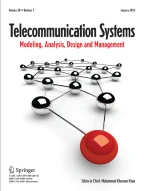Abstract
This paper considers a problem of configuring logical networks by employing a self-planning facility in a telecommunication network carrying voice-grade calls to make the least-cost configuration where the involved system cost includes hop cost and lost-call traffic cost. The hop cost depends on the number of self-planning facilities included on routing path connecting the associated node pairs, while the lost-call traffic cost is incurred due to link capacities. The configuration problem is analyzed through dimensioning and routing on a reconfigurable network in a mixed 0/1 nonlinear programming approach for which lower bounds are found by Lagrangian relaxation embedded in a hybrid search procedure for the associated dual problem. Heuristic solution procedures are exploited and their efficiencies are tested with various numerical examples.
Similar content being viewed by others
Explore related subjects
Discover the latest articles, news and stories from top researchers in related subjects.References
J.C. Bellamy,Digital Telephony (Wiley, New York, 1982).
P.M. Camerini, L. Fratta and F. Naffioli, On improving relaxarion methods by modified gradient techniques, Math. Progr. Study 3(1975)26–34.
A.A. Collins and R.D. Pederson,Telecommunications: A Time for Innovation (Merle Collins Foundation, Dallas, TX, 1973).
M.J. Lee and J.R. Yee, An efficient near-optimal algorithm for the joint traffic and trunk routing problem in self-planning networks,IEEE Globecom (1989), pp. 127–135.
M.J. Lee and J.R. Yee, A partial branch and bound design algorithm for reconfigurable networks, ICC (1991) 682–686.
B. Gavish and S.L. Hantler, An algorithm for optimal route selection in SNA networks, IEEE Trans. Commun. 31(1983)1154–1161.
B. Gavish and H. Pirkul, Efficient algorithms for solving multiconstraint zero-one knapsack problems to optimality, Math. Progr. 31(1985)78–105.
B. Gavish and K. Altinkemer, Backbone network design tools with economic tradeoffs, Working Paper (1989).
B. Gavish, P. Trudeau, M. Dror, M. Gendreau and L. Mason, Fiber optic circuit network design under reliability constraints, IEEE J-SAC (1989) 1181–1187.
A.M. Geoffrion, Lagrangian relaxation and its uses in integer programming, Math. Progr. Study 2(1974)82–114.
M. Gerla, J.A.S. Monteiro and R. Pazos, Topology design and bandwidth allocation in ATM nets, IEEE J-SAC 7(1989)1253–1262.
D. Ghosh and S. Mitra, Conguring express pipes in emerging telecommunication networks, Working Paper (1992).
A. Girard,Routing and Dimensioning in Circuit-switched networks (Addison-Wesley, 1990).
G. Gopal, C.K. Kim and A. Weinrib, Algorithms for reconfigurable networks, ITC 13(1991)341–347.
G. Gopal, C.K. Kim and A. Weinrib, Dynamic network configuration management, IEEE ICC (1990) 295–301.
E.P. Gould and C.D. Pack, Communications network planning in the evolving information age, IEEE COM Mag. 25(1987)22–30.
D.W. Hutcheson, Design and deployment of control services based on digital cross-connect systems,IEEE Globecom (1985) pp. 562–566.
D.L. Jagerman, Methods in traffic calculations, B.S.T.J. 63(1984)1283–1310.
A.A. Jagers and E.A.V. Doorn, On the continued Erlang loss function, Oper. Res. Lett. 5(1986)43–46.
M.K. Kerner, H.L. Lemberg and D.M. Simmons, An analysis of alternative architectures for the interoffice network, IEEE J-SAC 4(1986)1404–1413.
K.R. Krishnan, The convexity of loss rate in an Erlang loss system and sojourn in an Erlang delay system with respect to arrival and service rates, IEEE Trans. Commun. 38(1990)1314–1316.
R.A. Pazos-Rangel and M. Gerla, Express pipe networks,IEEE Globecom (1982) pp. 293–297.
B. Sanso, M. Gendreau and F. Soumis, An algorithm for network dimensioning under reliability considerations, Ann. Oper. Res. 36(1992)263–274.
P. Shinha and A.A. Zoltners, The mutiple choice knapsack problem, Oper. Res. 3(1979)503–515.
J.R. Yee and F.Y. Lin, A routing algorithm for virtual circuit data networks with multiple sessions per O-D pair, Networks 22(1992)185–208.
P.J. Zanella, Customer network reconfiguration applications utilizing digital cross-connect systems,IEEE Globecom (1988) pp. 1538–1543.
J.S. Park and H. Pirkul, Configuring distributed computer systems on value-added networks: A model and solution procedures, Working Paper (1992).
Author information
Authors and Affiliations
Rights and permissions
About this article
Cite this article
Sung, C.S., Park, S.K. An algorithm for configuring embedded networks in reconfigurable telecommunication networks. Telecommunication Systems 4, 241–271 (1995). https://doi.org/10.1007/BF02110089
Received:
Revised:
Issue Date:
DOI: https://doi.org/10.1007/BF02110089
